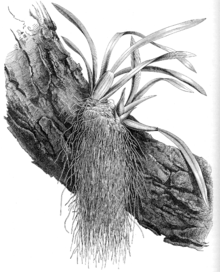Aerial root
Air roots are mostly formed by epiphytic plants. They are used to absorb water and nutrients from the air and z. T. the fixation on the substrate . These roots surround z. B. in orchids a spongy cell layer called Velamen radicum . When it rains or due to high humidity, these cells soak up water. The third picture shows the enlarged cross-section of an orchid aerial root. The red colored cells are lignified and permeable and allow the nutrients and moisture to penetrate the roots.
An increased formation of aerial roots can be caused by the fact that the plant is not adequately supplied by the earth roots. Insufficient climbing opportunities for a climbing plant can also lead to this effect.
Mangroves of the genus Rhizophora form (in addition to the arched stilt roots arising from the trunk ) on their branches, often vertically hanging aerial roots that can take on a support function when they reach the substrate. Similar roots can also be found in other tree species, e.g. B. Figs ( Moraceae ).
Individual aerial roots can be cut off if they interfere, but not all of them must be cut off. In the case of orchids, at most dead aerial roots should be removed.


